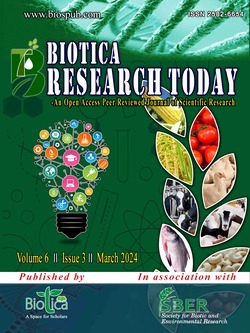
Floating Wetlands: A Green Oasis for Urban Water Bodies
Jeevitha J.*
Dept. of Aquatic Environment Management, Dr. MGR Fisheries College and Research Institute, Ponneri, Tamil Nadu Dr. J Jayalalithaa Fisheries University, Tamil Nadu (601 204), India
Akila A.
Dept. of Aquatic Environment Management, Dr. MGR Fisheries College and Research Institute, Ponneri, Tamil Nadu Dr. J Jayalalithaa Fisheries University, Tamil Nadu (601 204), India
Aruna S.
Dept. of Aquatic Environment Management, Dr. MGR Fisheries College and Research Institute, Ponneri, Tamil Nadu Dr. J Jayalalithaa Fisheries University, Tamil Nadu (601 204), India
Sona B.R.
Dept. of Aquatic Environment Management, Dr. MGR Fisheries College and Research Institute, Ponneri, Tamil Nadu Dr. J Jayalalithaa Fisheries University, Tamil Nadu (601 204), India
DOI: NIL
Keywords: Biodiversity enhancement, Floating treatment, Urban water management, Wetlands
Abstract
Urbanization poses challenges for urban water bodies, prompting the adoption of innovative solutions like floating wetlands. These artificial structures mimic natural wetlands, proving effective in mitigating algal blooms, removing pollutants and providing habitat for diverse organisms. This article examines the construction techniques for Floating Treatment Wetlands (FTWs), which have a variety of uses including improving water quality, enhancing biodiversity, managing runoff and fostering community involvement. Naturally occurring plants, floating or supported, play a vital role as hydroponic mats, acting as natural filters. The integration of floating wetlands into urban water management is advocated as a sustainable approach, delivering benefits for water quality, biodiversity and community well-being. This harmonious blend in urban planning ensures a healthier and more vibrant future for urban water bodies.
Downloads
not found
Reference
Chance, L.M.G., Van Brunt, S.C., Majsztrik, J.C., White, S.A., 2019. Short-and long-term dynamics of nutrient removal in floating treatment wetlands. Water Research 159, 153-163. DOI: https://doi.org/10.1016/j.watres.2019.05.012.
Chen, Z., Cuervo, D.P., Müller, J.A., Wiessner, A., Köser, H., Vymazal, J., Kästner, M., Kuschk, P., 2016. Hydroponic root mats for wastewater treatment - A review. Environmental Science and Pollution Research 23, 15911-15928. DOI: https://doi.org/10.1007/s11356-016-6801-3.
Hogg, E.H., Wein, R.W., 1988. The contribution of Typha components to floating mat buoyancy. Ecology 69(4), 1025-1031. DOI: https://doi.org/10.2307/1941258.
Stefanakis, A.I., 2020. Constructed wetlands: description and benefits of an eco-tech water treatment system. Chapter 25. In: Waste Management: Concepts, Methodologies, Tools, and Applications. (Ed.) Information Resources Management Association. IGI Global. pp. 503-525. DOI: https://doi.org/10.4018/978-1-4666-9559-7.ch012.
